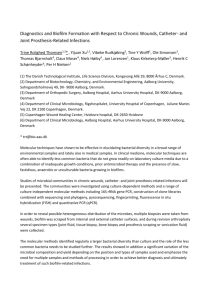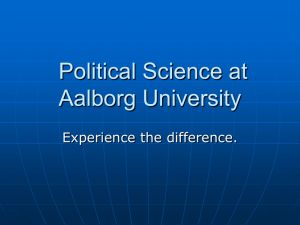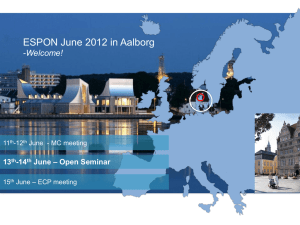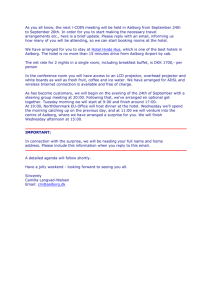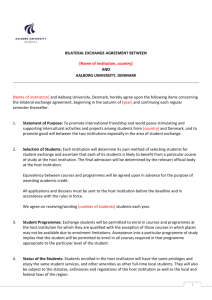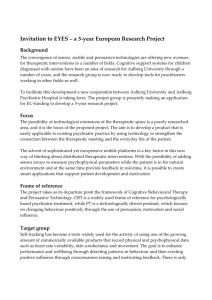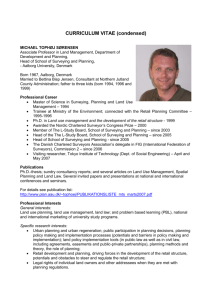Project-Organized Problem-Based Learning in Distance Education*
advertisement
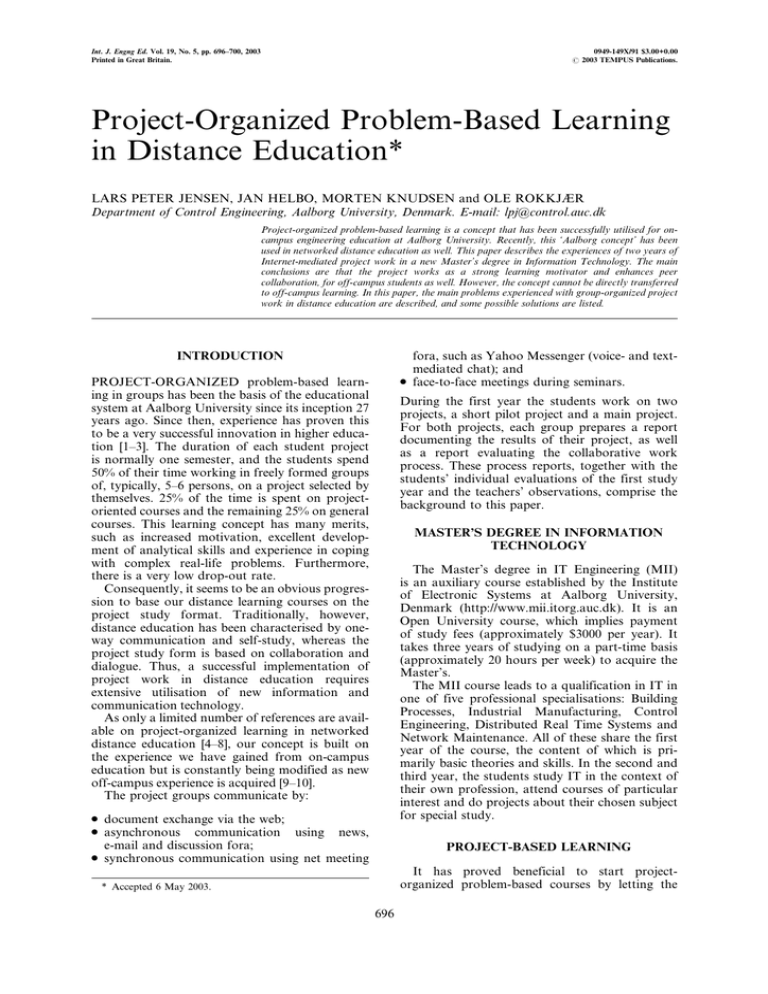
Int. J. Engng Ed. Vol. 19, No. 5, pp. 696±700, 2003 Printed in Great Britain. 0949-149X/91 $3.00+0.00 # 2003 TEMPUS Publications. Project-Organized Problem-Based Learning in Distance Education* LARS PETER JENSEN, JAN HELBO, MORTEN KNUDSEN and OLE ROKKJáR Department of Control Engineering, Aalborg University, Denmark. E-mail: lpj@control.auc.dk Project-organized problem-based learning is a concept that has been successfully utilised for oncampus engineering education at Aalborg University. Recently, this `Aalborg concept' has been used in networked distance education as well. This paper describes the experiences of two years of Internet-mediated project work in a new Master's degree in Information Technology. The main conclusions are that the project works as a strong learning motivator and enhances peer collaboration, for off-campus students as well. However, the concept cannot be directly transferred to off-campus learning. In this paper, the main problems experienced with group-organized project work in distance education are described, and some possible solutions are listed. fora, such as Yahoo Messenger (voice- and textmediated chat); and . face-to-face meetings during seminars. INTRODUCTION PROJECT-ORGANIZED problem-based learning in groups has been the basis of the educational system at Aalborg University since its inception 27 years ago. Since then, experience has proven this to be a very successful innovation in higher education [1±3]. The duration of each student project is normally one semester, and the students spend 50% of their time working in freely formed groups of, typically, 5±6 persons, on a project selected by themselves. 25% of the time is spent on projectoriented courses and the remaining 25% on general courses. This learning concept has many merits, such as increased motivation, excellent development of analytical skills and experience in coping with complex real-life problems. Furthermore, there is a very low drop-out rate. Consequently, it seems to be an obvious progression to base our distance learning courses on the project study format. Traditionally, however, distance education has been characterised by oneway communication and self-study, whereas the project study form is based on collaboration and dialogue. Thus, a successful implementation of project work in distance education requires extensive utilisation of new information and communication technology. As only a limited number of references are available on project-organized learning in networked distance education [4±8], our concept is built on the experience we have gained from on-campus education but is constantly being modified as new off-campus experience is acquired [9±10]. The project groups communicate by: During the first year the students work on two projects, a short pilot project and a main project. For both projects, each group prepares a report documenting the results of their project, as well as a report evaluating the collaborative work process. These process reports, together with the students' individual evaluations of the first study year and the teachers' observations, comprise the background to this paper. MASTER'S DEGREE IN INFORMATION TECHNOLOGY The Master's degree in IT Engineering (MII) is an auxiliary course established by the Institute of Electronic Systems at Aalborg University, Denmark (http://www.mii.itorg.auc.dk). It is an Open University course, which implies payment of study fees (approximately $3000 per year). It takes three years of studying on a part-time basis (approximately 20 hours per week) to acquire the Master's. The MII course leads to a qualification in IT in one of five professional specialisations: Building Processes, Industrial Manufacturing, Control Engineering, Distributed Real Time Systems and Network Maintenance. All of these share the first year of the course, the content of which is primarily basic theories and skills. In the second and third year, the students study IT in the context of their own profession, attend courses of particular interest and do projects about their chosen subject for special study. . document exchange via the web; . asynchronous communication using news, e-mail and discussion fora; . synchronous communication using net meeting PROJECT-BASED LEARNING It has proved beneficial to start projectorganized problem-based courses by letting the * Accepted 6 May 2003. 696 Project-Organized Problem-Based Learning in Distance Education students a short pilot project in administratively selected groups. This also seems to be true for distance education [6], so the pilot project chosen to begin the MII-study was titled: `Make a web site for your group, to present your projects and the group members'. The objective is for the student to gain experience with project and group work in distance education, and to test the relevant communication tools. The rest of the first year is used for the main project, where the groups are formed freely and select their project themselves within the given technical parameters, which is that they have to use a client/server application and a database for the solutions. An example of a project is: `A web-based system for sharing cars'. Learning approach A common belief about problem-based learning in groups performing a project is that reflection loops should play a prominent part. This understanding of learning processes is based on Kolb's learning cycle [11] and SchoÈn's ideas about reflection in the learning process [12]. These ideas are combined by John Cowan to create a learning concept based on planned reflection loops [13] or Kolb coils (paraphrased by Cowan as `experienceÐreflectionÐgeneralisationÐtest'). During a project period, three reflections are planned to enhance the learning process (see Fig. 1): . before (for), or at the very beginning of the learning process, to decide what the process will be to fulfil the learning needs; . in the middle of the process, to consider how the process so far has fulfilled the aims and objectives, whether they are still relevant and what changes, if any, are necessary; and . after (on) the learning process, in order to decide what has been accomplished and what is lacking, with the aim of improving the process for the future. One of the main purposes of this approach, with its three planned and guided reflection loops, is to encourage the participants to improve the quality, depth and relevance of what they have learned. During projects on campus which run over a longer period of time (six months or more), the students themselves reflect within their group several times between the planned reflections (see Fig. 2). Fig. 1. The Cowan diagram [13]. 697 Fig. 2. Modified Cowan diagram [13]. These small reflection coils seem to help shorten the individual knowledge gap between the students, and it is very important that they also take place in distance group work. Form The pilot project starts with a two-day seminar and runs for two months, with another seminar in the middle and an evaluation seminar at the end. At each seminar there is time for project work and, according to the learning approach, this is guided by reflections. The results of the first project [10] are used to improve the main project, which is very similar to the pilot project but runs for a longer time (seven months). The main project starts at the final pilot project seminar, with five additional seminars to follow. Formal guided reflections are held at the first, third and last seminars, according to the learning approach, and, although the remaining seminars are used primarily to enhance the courses, there is also time for project work and meetings with the supervisors, who guide more informal reflections to help improve project work. EXPERIENCE WITH THE PROJECT WORK Having had a lot of good and well-tried experience with project work on campus, the project work in distance education is best explained if compared to the on-campus project work. First the characteristics of the two types of student and the situation in which they study will be explained. The characteristics of an on-campus engineering student The typical M.Sc.E.E. student at Aalborg University is male, 18±25 years of age, and studies full-time, spending at least 40 hours a week at the university. The students' group has its own group room, which is the home base for most of the group's work. The students identify themselves as individual students for whom the group is pivotal, as this is where they help each other with the project and other study activities. Most of the groups also socialise outside of the university in their spare time. The projects are the driving force in the study and the groups work very hard to achieve a highquality project. This puts a kind of group pressure 698 L. Jensen et al. on each student to play his/her part properly and not let the others down by staying away. The characteristics of a distance education student MII students differ from the regular M.Sc.E.E. students in several ways: . they already hold at least a Bachelor's degree or its equivalent; . they usually have a full-time job and a family, and consequently very little time for studying; . they have varying level of IT skills (from IT professional to IT novice); and . they constitute a random group of people in terms of: age (25±56), previous education, and professional career. These students identify themselves as mature professionals. Their home and job is their base and have first priority when time is running short. They only spend two days every six weeks on campus, so they have almost no direct connection with the university. They have chosen to take this supplementary course supported by their company and their family, but studying is done after the company and the family are taken care of, which means mostly in the evenings and alone in front of the computer and books. Once or twice a week they `meet' with their group on the Internet, using voice- and text-mediated chat for a well-planned meeting (1±2 hours) to discuss their project work and possible problems with the courses. Positive experiences A lot of the positive aspects of on-campus project work seem to work in distance education as well: . Project work is a unique learning motivator. This is particularly important for distance learners, who study at home after a long day's work. . Project work enhances peer collaboration. Studying at home alone can be hard and lonely, and the student can get stuck on even minor problems. Collaboration may well provide the answer, offering a way forward. It is very important that students actually meet their fellow students regularly, so the seminars are essential. Students feel that most of their progress in the project happens here. This is especially true for the more complex and difficult parts of the project; where important decisions are made, faceto-face group work is needed. It has also been observed that the project management has a very high priority and that the sessions are used as milestones for the status of the project and an essential opportunity for the supervisor to discuss the project with the students. Other important factors in project work for distance education are: . Face-to-interface meetings combined with face-toface meetings. It is commonly felt that a good networked collaboration requires prior personal acquaintance. . Virtual group meetings with strict planning and control. In face-to-interface meetings, informal meetings are not adequate, but, with strict planning and control, meetings are a useful supplement to asynchronous communication. Negative experiences The members of the groups can have very different ambitions from the study and may not be equally confident with the project plan and the task/subtask definitions. This can result in the strong students progressing way beyond the weak students. As a consequence, the group members' professional skills can develop quite unevenly as the semester progresses. Some of the students also become unmotivated, unlike experiences with on-campus groups, where daily discussions between the students even out the differences. The curves in Fig. 3 show the professional progress of the best and the weakest student within a project group. On campus, the difference between the students decreases during each project (semester), but, for the distance education student groups, the difference seems to increase. The sharing of knowledge, both in the projects and in the courses, that normally takes place within a group on campus does not happen to the same extent during the first year of our distance education course, so we could conclude that: . peer collaboration in project work is enhanced between students who have the same level of ambition; . because exercises for the course are done individually by each student at home, they do not help each other and share knowledge in the way that on-campus students do; and . it seems that the Kolbian coils mechanism for sharing experiences does not automatically work during voice- and text-mediated meetings. Supervision of MII groups is a new and challenging situation compared to on-campus supervision, for several reasons: . If the supervisor participates in all the face-tointerface meetings, he is likely to become either a group member or `a fly on the wall', because the group will want to improve the efficiency of the meetings and will not want the supervisor to ask reflective questions. . If members of a group `hide' their work and don't contact the supervisor for a long time, he Fig. 3. Comparison between on-campus and MII groups. Project-Organized Problem-Based Learning in Distance Education cannot just `pop in' and see what is happening, but has to wait either for answers to his e-mails or for the next seminar. SUGGESTIONS FOR IMPROVEMENT For the MII-students, who are not accustomed to educational project work or distance education, the small-scale process-oriented pilot project is an excellent introduction to the main project work. However, as soon as the professional demands of both the projects and the courses increases, the progress of the group members diverges. After two years of continuous (but small) improvements to the first year of the MII course, the supervisors believe that the following recommendations would greatly improve the course: . Groups should be more homogeneous. As it seems that different levels of motivation between group members increases skill diversity, it is important that all group members have similar levels of motivation. We will try to enhance this by spending more time on the process of group formation and project selection. Smaller groups (of three to four) will be accepted and considerable emphasis will be placed on the importance of having the same level of motivation and time to put into the project, as well as agreement and understanding of the project task. . The project-organized model should be tailored to better suit distance education. As project work on campus seems to even out professional skills between students, distance education courses and project work must be organised so that the groups are forced to reflect in a Kolbian coil manner. This can be done by focusing on discussions in fora connected with the courses, whereby students can share reflections that will highlight where and why group members are having problems. In this way, the students can help each other through quality discussion. It would also be helpful to integrate the project work and courses as much as possible, so that all projects follow the same format. This would help the teachers when planning the content of the courses, which will be useful for the students when looking for project solutions, and will also help teachers set project-related assignments in the course. This should be followed up by evaluating the students at the first seminar following the end of the courses, when it is expected that the technical level will have generally improved. 699 . The role of the supervisor should be adapted to distance education and to the characteristics of the distance education students. The supervisor role is far less satisfactory than in the on-campus situation (e.g. it is difficult to promote reflection at the face-to-interface meetings). The role of the supervisor has to be tailored to suit the special conditions of distant group work, focusing on the one hand on the immediate problem-solving needs of the group and on the other on students' learning needs for reflection. This is a very difficult task, because each relationship between supervisor and student is new and unique and will develop differently according to the project and its conditions. Supervisors need to try to improve the quality of their supervision by being aware of what they are doing and logging their reasoning and the results, so that there can be ongoing discussion and sharing of experiences between supervisors. CONCLUSION AND FUTURE WORK Experience with project-organized problembased learning in distance education courses in engineering shows that a lot of the benefits of the educational system at Aalborg University are transferable to distance education, making it worthwhile continuing efforts to improve the MII programme. Two research projects have been defined for this purpose: Virtual Learning Environments and Learning Forms (ViLL), part of the project `Digital North Denmark', and `Didactic methods in ICT-supported projectorganized distance education', supported by the `Danish engineering pedagogic network'. These projects will undertake a full-scale experiment with the first-year students of the 2001 MII course, implementing and evaluating the suggestions for improvement listed above. Future possibilities for improving face-to-interface meetings by using technical supports such as high-quality real-time video will also be tested in a brand new e-learning lab. The last two years of the MII course have applied very little rigorous planning between courses and projects. This will also be investigated further. AcknowledgementsÐThis work was supported by the ViLL project (Virtual Learning Environments and Learning Forms) under the `Digital North Denmark' initiative, and by IPN (Pedagogical Network for Engineering Education in Denmark). REFERENCES 1. F. K. Fink, Integration of engineering practice into curriculum, 29th ASEE/IEEE Frontiers in Education Conference, San Juan, Puerto Rico (1999). 2. F. Kjñrsdam and S. Enemark, The Aalborg Experiment: Project Innovation in University Education, Aalborg University Press (1994) (http://www.teknat.auc.dk/teknat_home/experiment/). 700 L. Jensen et al. 3. A. Kolmos, Reflections on project work and problem-based learning, European Journal of Engineering Education, 21(2) (1996), pp. 141±148. 4. D. P. Brandon A. B. and Hollingshead, Collaborative learning and computer-supported groups, Communication Education, 48(2) (1999). 5. A. Bygholm, O. Hejlesen and C. Nùhr, Problem-oriented project work in a distance education program in health informatics, MIDINFO 98, 1M1A, IOS Press, Amsterdam (1998). 6. A. Bygholm and L. Dirckinck-Holmfeld, Pedagogic in the virtual learning environment [in Danish], in O. Danielsen (ed.), Learning and Multimedia [in Danish], Aalborg Universitetsforlag, Denmark (1997). 7. D. Stamps, My anonymous adventures in cyberspace, Training, 36(4) (1999) (http://proquest.umi. com/pqdweb). 8. C. D. Whittington and N. Sclater, Building and testing a virtual university, Computers Educ., 30(1/2) (1998). 9. J. Helbo, M. Knudsen, L. P. Jensen, O. Borch and O. Rokkjñr, Group organized project work in distance education, ITHET 2001 Conference, Kumamoto, Japan (July 2001). 10. M. Knudsen, J. Helbo, O. Borch, L. P. Jensen, O. Rokkjñr and J. éstergaard, Project work in networked distance education, 2nd International Conference on Networked Learning, Lancaster University (April 2000). 11. D. A. Kolb, Experimental Learning: Experience as the Source of Learning and Development, Prentice-Hall, Wilton (1998) (http://proquest.umi.com/pqdweb). 12. D. A. SchoÈn, Educating the Reflective Practioner: Toward a New Design for Teaching and Learning in the Professions, Jossey-Bass (1987). 13. J. Cowan, On Becoming an Innovative University Teacher: Reflection in Action, SRHE and Open University Press, Buckingham (1998). Lars Peter Jensen received his M.Sc. from Aalborg University in 1980. He has been working there ever since, as Associate Professor in the Department of Control Engineering. His first research project was the development of a ground speed controller for a combine harvester, and from there he moved on to designing man±machine interfaces within the process industry. He has a special interest in ergonomics in the control room, especially during organisational change. This has led to a new research focus on learning processes both within companies trying to establish a `developing workplace' and at the university, where he is trying to improve teamwork skills among first-year students. Morten H. Knudsen received his M.Sc. in electronic engineering from the Technical University of Denmark in 1963 and his Ph.D. from Aalborg University in 1993. From 1965 to 1971 he worked with the Servo Laboratory, the Technical University of Denmark, General Dynamics (Rochester, New York) and the Measurex Corporation (Santa Clara, California). He was an Associate Professor from 1971 and, from 1990, Reading Professor (Docent) in control engineering at the Institute for Electronic Systems, the University of Aalborg, Denmark. His main interests have been modelling, system identification and control (e.g. in relation to cancer hyperthermia systems, loudspeakers and ac-motors). In recent years, a considerable part of his time is spent working on IT-based learning and on `The IT Initiative', a programme for equipping Aalborg University to meet the IT age. Jan Helbo received his M.Sc. in electronic engineering from the Technical University of Denmark in 1972. He was Assistant Professor between 1972 and 1976, first at the Engineering Academy of Denmark, Aalborg, and then in the Department of Control Engineering after the foundation of Aalborg University. Since 1976, he has been Associate Professor, heading the Department of Control Engineering in the period 1993±1999. His main research interest is in robotics, and he has designed control systems involving intelligent sensor controls, curve planning and sophisticated control algorithms. His current interest is in ultrasonic friction motors for joint control. As an experienced supervisor in problem-based project-organized group work, he is very involved in the process of converting the `Aalborg model' to distance IT and IT-based learning. Ole Rokkjñr is the co-ordinator of the Master's degree in Information Technology at Aalborg University. He received a B.Sc. in electronics engineering from Aalborg University in 1989 and has studied adult pedagogy. In the last decade, he has been teaching at Aalborg Day College and is employed as a consultant by the Unemployment Fund for Danish Engineers (IAK).
